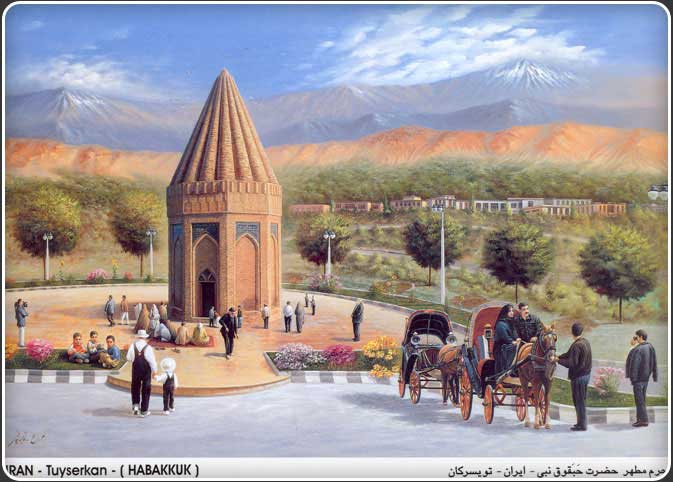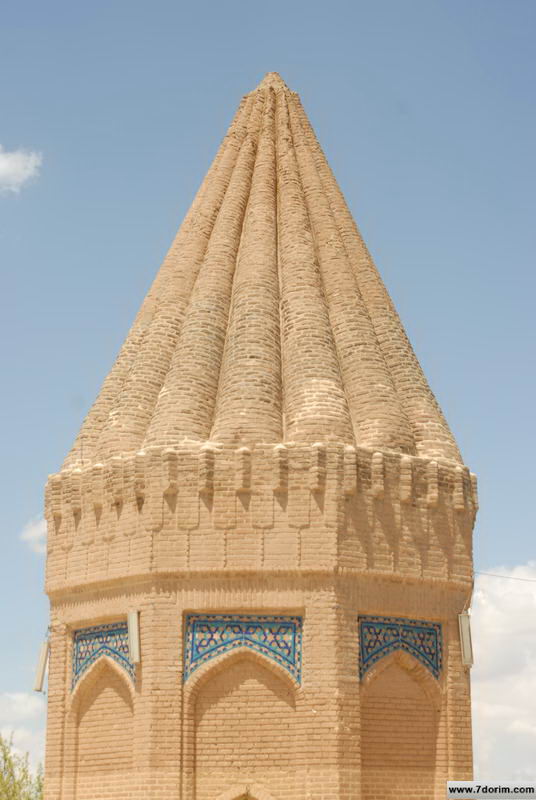
The tomb of Prophet Habakkuk in Tuysarkan has been restored several times over the centuries.
This tomb is one of the ancient monuments of Iran.
To see 360-degree images (panorama) of Habakkuk Nabi Shrine, please click
Would it be an exaggeration to refer to Hamedan (Iran) as the sanctuary of prophets and the prayer place of the companions? Hamedan and other cities of the province are the resting place of Esther and Mordecai and several other Divine prophets.
The body of Prophet Haggai rests in the Peyghambar Mosque of Hamedan, Prophet Habakkuk in Tuyserkan, Prophet Seth in a village with the same name (among the villages of Qahavand), and Prophet Khidr near a village called Khizr in Hamedan. These Divine messengers have peacefully entered eternal sleep here, and for centuries, Hamedan has been a host to these heavenly envoys.
Prophet Habakkuk comes from the lineage of Prophet Moses who lived 600 years before the birth of Jesus. In Hebrew, “Habakkuk” means “hugged” — a name that is directly related to a childhood miracle for Habakkuk. It is believed that Habakkuk died when he was a child. His grieving mother hugged him and placed him in his bed before going to prayer to ask God to give him another life. Habakkuk was revived before his mother had completed her prayer. Hence the name “Habakkuk”, meaning “the hugged”.
Prophet Habakkuk was appointed as a prophet 607 years before the birth of Jesus, after the prophecy of Prophet Shuaib. During a debate with scholars of different religions in the court of al-Ma’mun, the Abbasid caliph, Imam Reza mentioned Prophet Habakkuk while addressing a Jewish scholar. According to Bihar al-Anwar, Volume 10, Page 303, Prophet Habakkuk foretold the mission of the esteemed Prophet of Islam, Muhammad (peace be upon him). In the supplication of Imam Dawood, Prophet Habakkuk’s name is also mentioned, as seen in Volume 11, Page 59, and Volume 14, Page 62 of the same book.
Prophet Habakkuk’s birth date and birth place are not well-documented, but historical writings suggest that he served as the manager and guardian of the religious ceremonies at the Temple of Prophet Solomon in Jerusalem. After the conquest of Jerusalem by King Nebuchadnezzar – the tyrant of Chaldea (Babylon) – Prophet Habakkuk, along with many Jews including Prophet Daniel, was taken captive to Babylon. They remained in captivity for many years until Cyrus, the founder of the Achaemenes dynasty, conquered Babylon in 538 BC. Cyrus ordered the release of all captives and encouraged them to return to Jerusalem.
After the liberation of the Jews from Babylonian captivity, Prophet Habakkuk went to Iran along with some of his followers and settled in what is currently known as Tuyserkan, where he stayed until his death. Prophet Habakkuk’s tomb is one of the oldest historical monuments in Tuyserkan, with a history of approximately 2,500 years. The construction of his mausoleum, with its intriguing architectural style, likely dates back to the Seljuk period. The mausoleum was outside the Southwestern borders of the city until a few years ago, but has now become part of the city as Tuyserkan expanded.
The mausoleum building, resembling a round tower from a distance, has eight levels and reaches a height of 12 meters. Its unique cone-shaped roof may be considered unparalleled among the historical structures in Iran. The mausoleum has an entrance with a meshed iron double door, and above it, there are arch-shaped inscription doors. There used to be a large stone-door there that was very difficult to open and close. But it is unknown where that stone door is now.
Prophet Habakkuk’s grave is exactly in the center of the courtyard, with a stone placed on it, bearing inscriptions in both Persian and Hebrew. A wooden box covered with green fabric is on the grave, and a history of Prophet Habakkuk is inscribed on one of its side surfaces. The inscription reads, “Prophet Habakkuk, a prophet of the Children of Israel and the lineage of Prophet Moses. He was the son of Shioua Lovit and Lesho Namit, a singer and performer of religious ceremonies at the Temple of Prophet Solomon. He lived during the reign of Zedekiah and, after the destruction of the temple by the Chaldeans in 586 BC, was captured by the Babylonians along with Prophet Daniel and others. He passed away after some time.”
Until recently, the locals were unaware of the architectural quality of this site, thinking that the mausoleum’s facilities were limited to its octagonal walls and the dome on the grave. However, it was later discovered that a large underground floor also exists, forming an interesting three-tier structure, likely untouched over the centuries. This part remained hidden due to the absence of any visible entrance or passage; the entire surface and floor of the mausoleum are uniformly sealed and paved with bricks.
In the past, people had no knowledge of the identity and significance of the occupant of this tomb. This lack of awareness led to a lack of proper respect. However, thanks to the guidance of religious scholars, especially the late Khalesi-Zadeh, people became aware and respectful of the holy figure resting in the mausoleum.
Habakkuk has been mentioned in the Torah and holds a special religious respect among Jews. His book holds a prominent position in the Jewish religion. The Book of Habakkuk is 35th Sefirot. The Vatican Museum also hosts sculptures and images of Prophet Habakkuk.
Ofogh-e Bina Magazine, Volume 31
 The exterior view of the conical tomb of Habakkuk shrine along with its saber space: taken from the archive of toyserkan.com
The exterior view of the conical tomb of Habakkuk shrine along with its saber space: taken from the archive of toyserkan.com

Prophet Habakkuk shrine

Prophet Habakkuk shrine

Prophet Habakkuk shrine

Prophet Habakkuk shrine

Prophet Habakkuk shrine

Prophet Habakkuk shrine

Prophet Habakkuk shrine

Prophet Habakkuk shrine

Cold brick and tile view of the entrance to the shrine of Prophet Habakkuk
Photo archive of Tosirkan 2005

Prophet Habakkuk shrine

Prophet Habakkuk shrine

Prophet Habakkuk shrine
The image assigned to Prophet Habakkuk

Prophet Habakkuk shrine

Prophet Habakkuk shrine

Prophet Habakkuk shrine

Prophet Habakkuk shrine

Prophet Habakkuk shrine

Prophet Habakkuk shrine

Prophet Habakkuk shrine

Shrine of Prophet Habakkuk, interior view of ceiling, chandelier and rosary

Photo of interior view of ceiling and chandelier
Taken from toyserkan.com
Year 2005

Prophet Habakkuk shrine

Prophet Habakkuk shrine

Prophet Habakkuk shrine

Prophet Habakkuk shrine

Prophet Habakkuk shrine

Image of the shrine building, from the adjacent boulevard
toyserkan.com
Year 2005

Image of the shrine building, from the adjacent boulevard

The image of the shrine of Habakkuk Nabi in the winter of 2004

The sacred box on the tomb of Habakkuk Nabi
Year 2005

The sacred box on the tomb of Habakkuk Nabi

The sacred box on the tomb of Habakkuk Nabi

The sacred box on the tomb of Habakkuk Nabi

The sacred box on the tomb of Habakkuk Nabi

The holy box on the tomb of Habakkuk (view from the side)
Taken from toyserkan.com
Year 2005

Antiquities of stone tablet inscriptions with Hebrew script in Tuysarkan (more than 500 years old)

The symbolic image of the prophet Habaquq, a work of the 18th century Russian artist and painter, taken from wikipedia

The symbolic image of the prophet Habakkuk, a work of the 18th century Russian artist and painter, taken from wikipedia

The statue of the prophet Habakkuk, the work of the 15th century artist and carver Donatello, Italy – Florence Museum

The image of the Prophet Habakkuk Shrine in Kadarim
Prophet Habakkuk is one of the prophets of Bani Israel belonging to the Hebrew year 3072. He was one of the servants and close friends of Solomon’s temple (Beit Hamiqdash), who was taken captive to Babylon by Bakht al-Nasr after the destruction of Solomon’s temple. After the defeat and capture of Babylon by Cyrus the Great, he migrated to the land of Iran along with other elders of the Jewish people, such as Daniel the prophet. .
The name Habakkuk in Hebrew culture means embraced or embraced.
According to some disciples of Prophet Habakkuk, his tomb is in the city of Kadarim located in the north of Israel.
To see 360-degree images (panorama) of Habakkuk Nabi Shrine, please click


